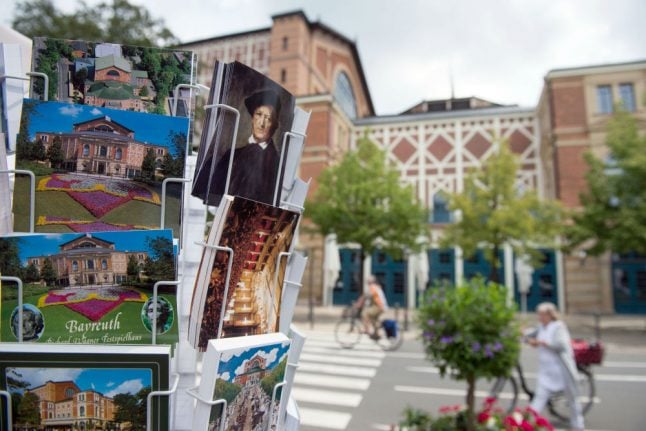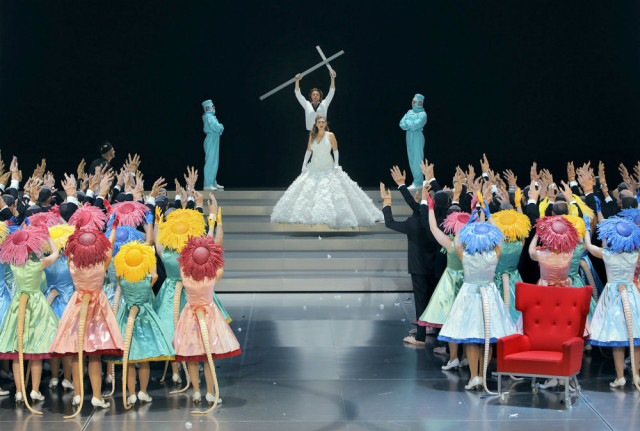Around 30 minutes into the performance, a piece of the staging came unstuck and fell off, forcing management to ask the audience to leave the building until the fault was fixed.
Things scarcely improved when the audience returned for the opening night production of "Tannhäuser" by German director Sebastian Baumgarten, which dates back to 2011 and is deeply unpopular with audiences and critics alike.
It sets Wagner's tale of the wandering knight-minstrel in a modern bio-gas plant and the boos and whistles were almost deafening when director Baumgarten took his bows at the end of the evening.
One audience member from Berlin, who gave his name as Juergen, said he would be "glad to see the back of this Tannhäuser."
Michael and Achim from Frankfurt, were equally nonplussed by the staging.
"It's awful. It's got absolutely nothing to do with Wagner's intentions," Michael said.
The festival's opening night is traditionally a glitzy affair attended by Germany's political and social elite, even if Chancellor Angela Merkel was absent this year for the first time in years.
Spectators had nevertheless lined the avenue leading up to Bayreuth's fabled Festspielhaus, the theatre built to Wagner's own designs, to watch the seemingly endless stream of limousines arrive for a performance of "Tannhäuser".
The VIPs paraded along the red carpet in their ballgowns and tuxedos to be welcomed by the festival chiefs and the composer's great-granddaughters, Katharina Wagner and Eva Wagner-Pasquier.
A "diary clash" was the official reason for Merkel's absence — she is an ardent Wagnerian and has attended the festival in the southern German town regularly since before she became chancellor in 2005.
Festival spokesman Peter Emmerich insisted she would turn up for a couple of performances next week.
"It's a shame Merkel isn't here this year. We come every year just to watch the opening," said a Bayreuth local who identified himself only as Horst, accompanied by his wife Ute.
Following last year's Wagner Bicentenary, when a highly controversial new production of the four-opera "Ring" cycle was unveiled by the iconoclastic German director, Frank Castorf, no new productions are scheduled this year.
This will be the final year for the "Tannhäuser". It will be replaced in 2015 by a new staging of "Tristan and Isolde" by Katharina herself.
While tickets for the festival are notoriously difficult to come by, with waiting lists of 10 years and more, there is growing dissatisfaction with the artistic choices made by half-sisters Katharina and Eva.
The highbrow daily Frankfurter Allgemeine Zeitung recently complained the festival is suffering from "artistic arteriosclerosis" and was "about as exciting as stale beer".
Only a handful of hopefuls stood holding "ticket wanted" notices at the box office.
"I know this 'Tannhäuser' isn't supposed to be very good. But I'd still love to get in, just to say I've been here. Perhaps I'll strike it lucky and someone will give me their ticket after the first interval," said Peter Gruenbaum, who said he had travelled down from Cologne especially.
Last year audiences booed, whistled and jeered Castorf's "Ring" for more than 15 minutes after its premiere.
The bizarre staging set Wagner's story in faraway places such as Baku, Azerbaijan, and featured prostitutes, gangsters, Kalashnikov rifles and copulating crocodiles.
While the festival chiefs stood firmly behind Castorf last year, the outspoken director lashed out at Katharina and Eva in a magazine interview
this week.
He accused them of treating him like an "idiot" and ruling over the festival with an atmosphere of fear and intimidation familiar from communist East Germany where he grew up.
This is the last year in which Katharina and Eva will be jointly in charge of the festival.
Eva is retiring at the end of this year's event, leaving Katharina in sole charge.
The Bayreuth Festival runs until August 28, with a total 30 performances of seven different operas – "Tannhäuser", "The Flying Dutchman", "Lohengrin" and the "Ring" comprising "Rhinegold", "The Valkyrie", "Siegfried" and "Twilight of the Gods".




 Please whitelist us to continue reading.
Please whitelist us to continue reading.
Member comments